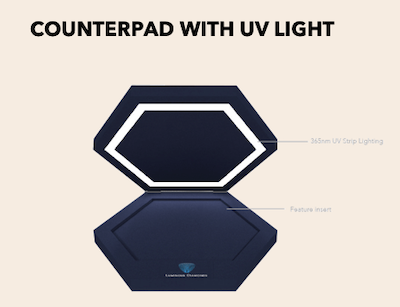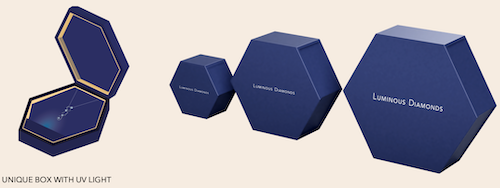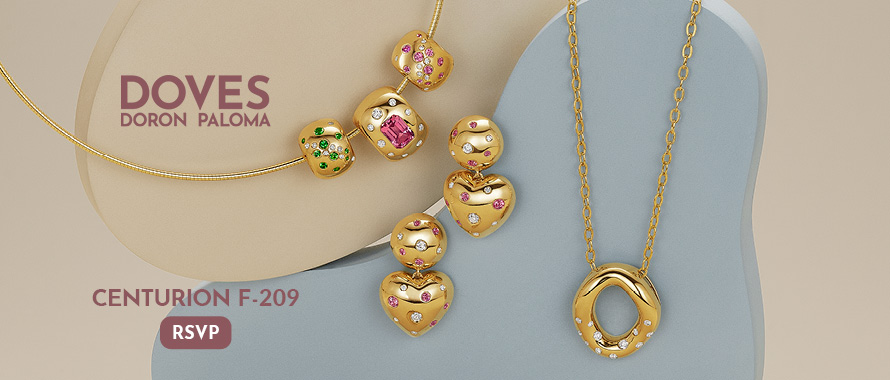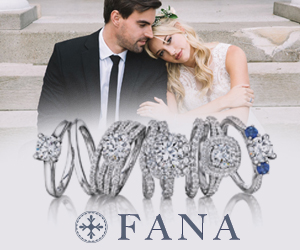Sales Strategy
Selling A Unique Story: Alrosa, A. Link Highlight Fluorescence As USP For New Diamond Collection | October 21, 2020 (0 comments)

New York, NY—For years, fluorescent diamonds have gotten a bad rap in the industry. Now, Alrosa and A. Link & Co. are seeking to flip the perception with a new collection, a compelling story, and research showing the characteristic resonates with consumers.
Fluorescence as a diamond characteristic was first described in 1940 by Robert M. Shipley, the patriarch of both the Gemological Institute of America and the American Gem Society, and Richard T. Liddicoat, GIA’s renowned gemologist. 30 years later in 1970, some diamond traders also noticed that “milky” stones tended to be fluorescent as well. A classic fallacy of the converse—milky stones were likely to be fluorescent, but not all fluorescent stones were milky—led to lasting misconceptions about value, and discounts on stones exhibiting fluorescence ranged from 15% (Rapaport) to as high as 35% in the market.
There were no scientific grounds for devaluing fluorescent stones, says Rebecca Foerster, president of Alrosa USA. Together with A. Link, Alrosa is now betting on fluorescence as a positive diamond attribute to appeal to Millennial buyers and female self-purchasers seeking something unique and personal in everything they buy.
For starters, it’s rare. According to GIA, only one-quarter of all diamonds show any fluorescence, and just 2% to 3.5% show medium to strong fluorescence. And in 2018, HRD Antwerp concluded that common beliefs about fluorescence are misleading—particularly those equating it with milkiness, says Foerster. Fewer than 0.2% of all fluorescent stones submitted to GIA for grading exhibited a milky effect, and it was determined that was because of other factors occurring in the diamond’s formation, not because of fluorescence.
AGS Laboratories director Jason Quick crunched some data and found that while milkiness wasn’t a factor in the likelihood of fluorescence, color was. The lab found the percentage of diamonds exhibiting medium to very strong fluorescence was a little below 5% for D through H colors, but increased to about 20% for N color diamonds.
“Said differently, diamonds in the K to N range are much more likely to exhibit Medium to Very Strong fluorescence than diamonds in the D to H range. Diamonds with I or J color are moderately more likely to exhibit Medium to Very Strong Fluorescence than diamonds in the D to H range,” he concluded.
He also pointed out that in fancy shapes, any fluorescence tends to be concentrated in the same areas of the diamond as the color.
But none of that matters unless consumers find fluorescence a positive trait. Alrosa conducted extensive research, showing fluorescent diamonds to consumers. Reactions were positive, including such descriptions as “cool,” “unique,” and “exciting.” A survey of more than 2,000 diamond jewelry customers found the concepts of “a secret that only you know” and “celebrating the inner light in every woman” resonated very well.
That led to the development of the “Luminous Diamonds” brand and a partnership with leading luxury brand A. Link—an Alrosa sightholder—to create a new collection for better independent jewelers. The jewelry, designed by A. Link’s designer in Italy, will be distributed by the company’s regular sales force.
“We’re a mining company. We have marketing capabilities, but we don’t have the infrastructure for sales or manufacturing. We chose A. Link as a partner because they do beautiful product and they’re also a division of SDC/M. Suresh, an Alrosa sightholder. The vertical integration works beautifully,” says Foerster.
Selling the “wow” factor. The premise of the Luminous Diamonds collection is a celebration of women, and the inner traits that make each woman unique and strong. Those attributes are tied to the fluorescence of the diamond, which is only visible under certain kinds of light.

A special clamshell counterpad features a 365 UV wavelength light to show off the Luminous Diamonds' fluorescence.
But telling the customer about it isn’t nearly as effective as showing her. “We worked for months and months to find a way to deliver the best ‘wow’ effect at point of sale and all the way back to the customer’s home,” says Foerster.
The result is a turnkey marketing program that centers around a special light that makes the diamond glow. After testing multiple diodes and settling on a 365 UV wavelength, that light is incorporated into every element of the presentation—including the display, the counter pad, a rechargeable box the customer takes home, and even a little charm she can use for a keychain or hang on her purse so she can show her friends the diamond’s glow. All feature the brand’s signature hexagon shape, a stylish geometric that also resonated well in consumer research.

Luminous Diamonds' box is rechargeable to give consumers a chance to show off the fluorescence of their diamonds.
“It immediately gives the retailer a theater effect that will make consumers say, ‘what is that?’” says Foerster.
Marketing materials also include advertising assets, educational brochures, and so forth. The brand includes three design collections—Moonlight, Lucent, and Starlight—to appeal to multiple tastes and budgets.






